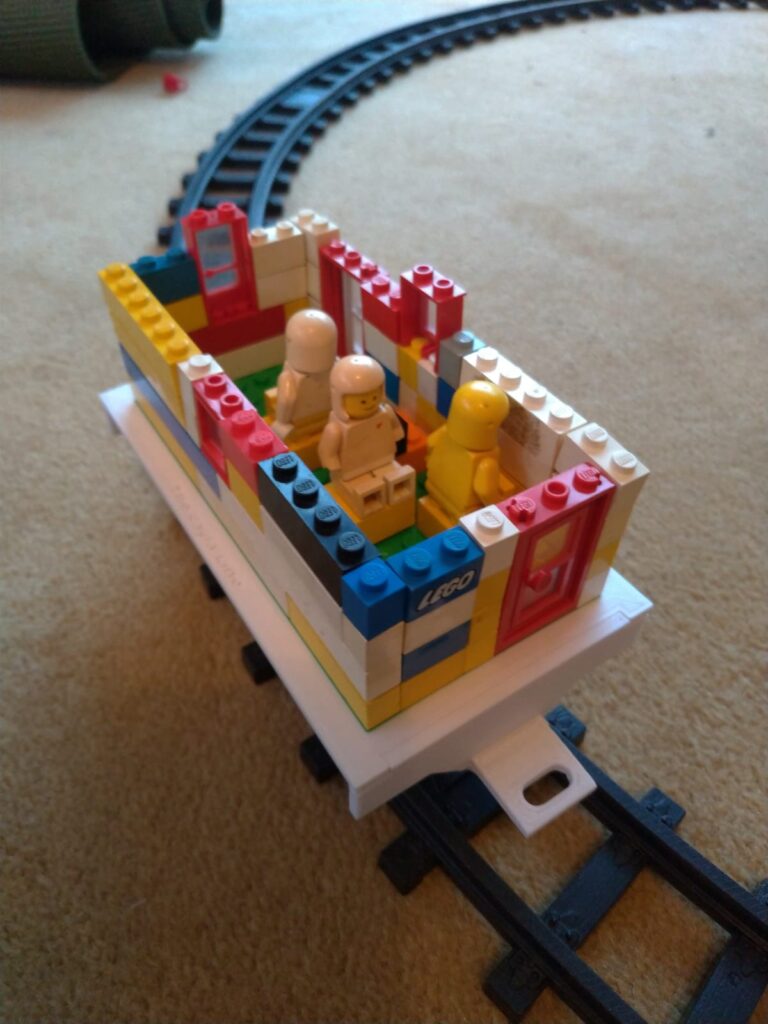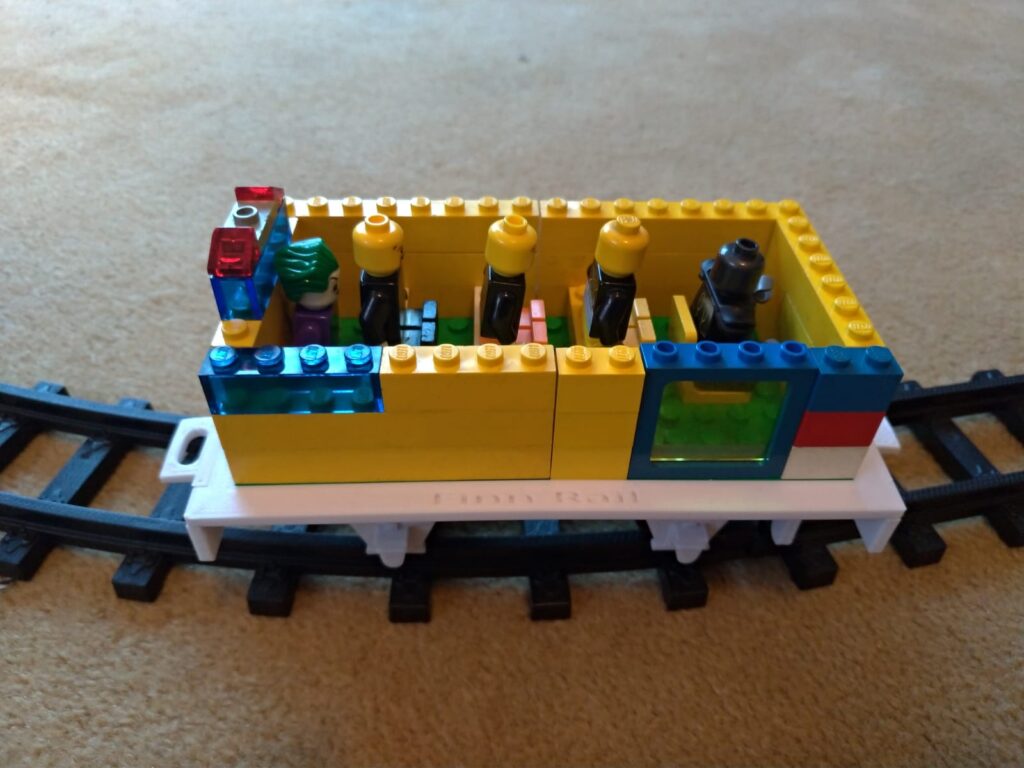One of the first drawings I did to 3D print was for parts to make Christmas presents for my nephews and niece.
“I bought them the Tesco ‘Caterpillar’ trainset last Christmas as a cheap way to try to get them into garden railways, with a couple of open coaches for Playmobile people made from The Works boxes to combine it with their existing toys. In which spirit, I thought I’d make them flatbed wagons this Christmas, with a Lego top, so they could build their own superstructure, and my 3D printer arrived a just the right time!”
Garden Rails Forum post, 15 Dec 2020
I didn’t draw everything myself – instead I used the solebars from GE_Rik’s Southwold Van on Thingiverse.

“Initially I thought they might be too breakable for the youngsters, given the nice details, but they are suitably robust!
“However I needed to create custom buffer beams – with couplings compatible with the Lego train… For this I started using TinkerCAD which has a remarkably intuitive interface for a 3D drawing package.”

I had to do this from memory. Owing to Covid-19 restrictions I wasn’t going to be able to measure any couplings, but one of the benefits of 3D printing is the ability to easily adjust drawings and reprint as necessary. Here’s the printed coupling:

“…of course the main feature is having a ‘Lego’ surface to the wagon, so I’ve been playing with Lego from Thingiverse, which has lead me into discovering parametric 3D designs…
“Thingiverse has a ‘Customiser’ which allows you to specify exactly what brick you would like (I’ll have a 4×1 or a 2×2 or whatever) and then generates it, based on SCAD files rather than STL files. Unfortunately, the customiser does not appear to work… It just put my requests in a queue where they remain unprocessed. Fortunately, it appears you can do the customising on your own computer – by downloading OpenSCAD, the programme for making the SCAD files, and using the customiser within that. Pretty soon I’d exported and printed some bricks, and figured out that a plate of 10 x 18 would be a good width (80mm) and a good match for the length of the solebars…”
OpenSCAD has gone on to be my main drawing package, but at the time it was just a means to an end, printing lego with the appropriate number of rows and columns…

“Unfortunately my Lego bricks were something of a wash out. They didn’t clip on to each other, and worse the plate was uneven with a poor finish. One of the pips even broke off…”

“…and if that happens when I’m handling it, it won’t stand up to the kids. By the look of it, the whole thing moved during printing (poor adhesion?) but it takes a while to print, and given the brick quality, I’ve lost some confidence. So I’ve hastily ordered some real Lego, if necessary I will incorporate it into the wagon. As I understand it, it is ABS and so should bond quite well with an ABS-printed frame…”
My subsequent experiences with the printer indicate it just isn’t capable of the precision required for lego.
“The beginner’s problem – not realising what is easy and what is hard. When I did realise what I was doing was probably a bit ambitious I ordered the bits of lego from eBay,”




Unfortunately the Duplo plate did not turn up in time, so the youngest got his late… but since he was too young to have serious expectations of Christmas (his previous one had been a third of a lifetime ago) it did not matter too much!
I despatched the other lego wagons which arrived in time for Christmas and immediately formed the basis for some smart new coaches…


Epilogue
However, there was a problem:
“Whilst the wagons with their short wheelbase run well on the Tesco track, and couple to each other without issue, they don’t play well with the Tesco train. The reason for this is that the Tesco wagons have a long wheelbase, and to compensate for this, although they are 4-wheelers, their axles are mounted in… can we call them bogies if they are a single axle? Or are they ‘trucks’ (like on a skateboard?) Anyway, the coupling is fixed to these bogies, designed so that the coupler pulls the wheels in on the curves… But coupled to my wagons, with the fixed couplings protruding from the buffer beam, the coupling is held out and the wheels are unable to follow the curve causing binding and if not derailment then loco wheel-slip.”
Garden Rails Forum post, 27 Dec 2020
So I needed to design a new swivelling coupling…




If you want to print your own lego wagon, you can download the drawings from Thingiverse.

